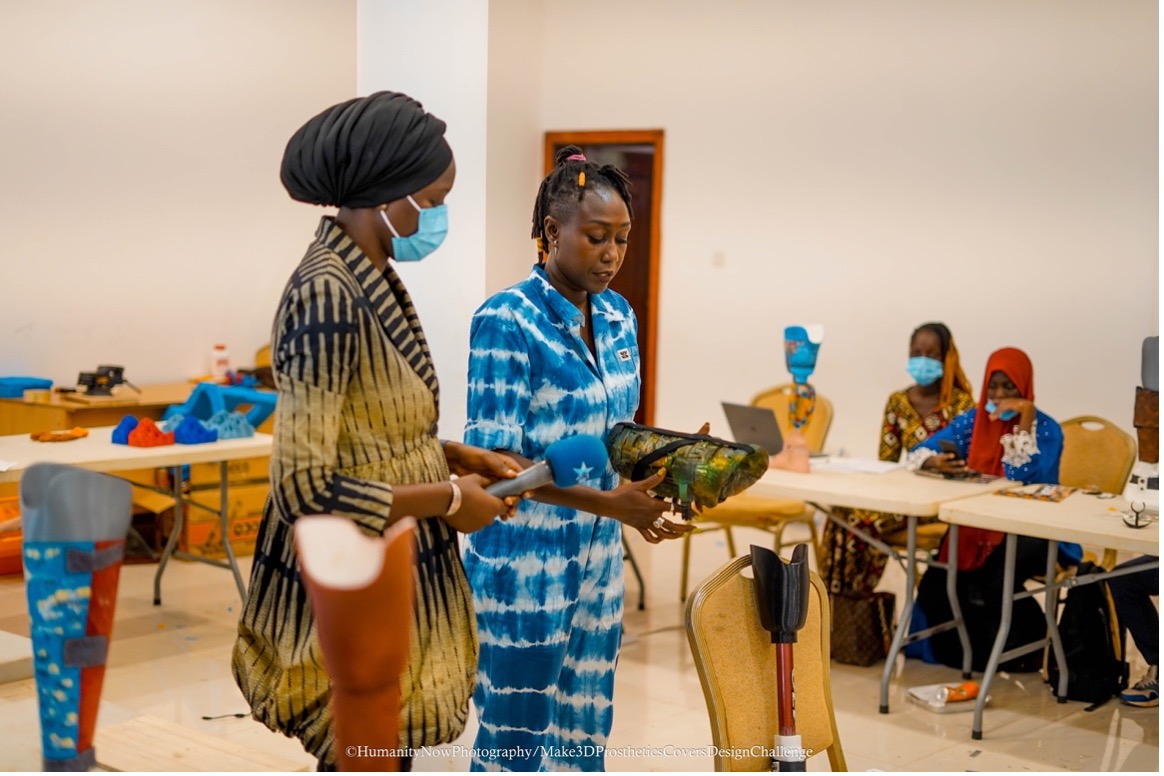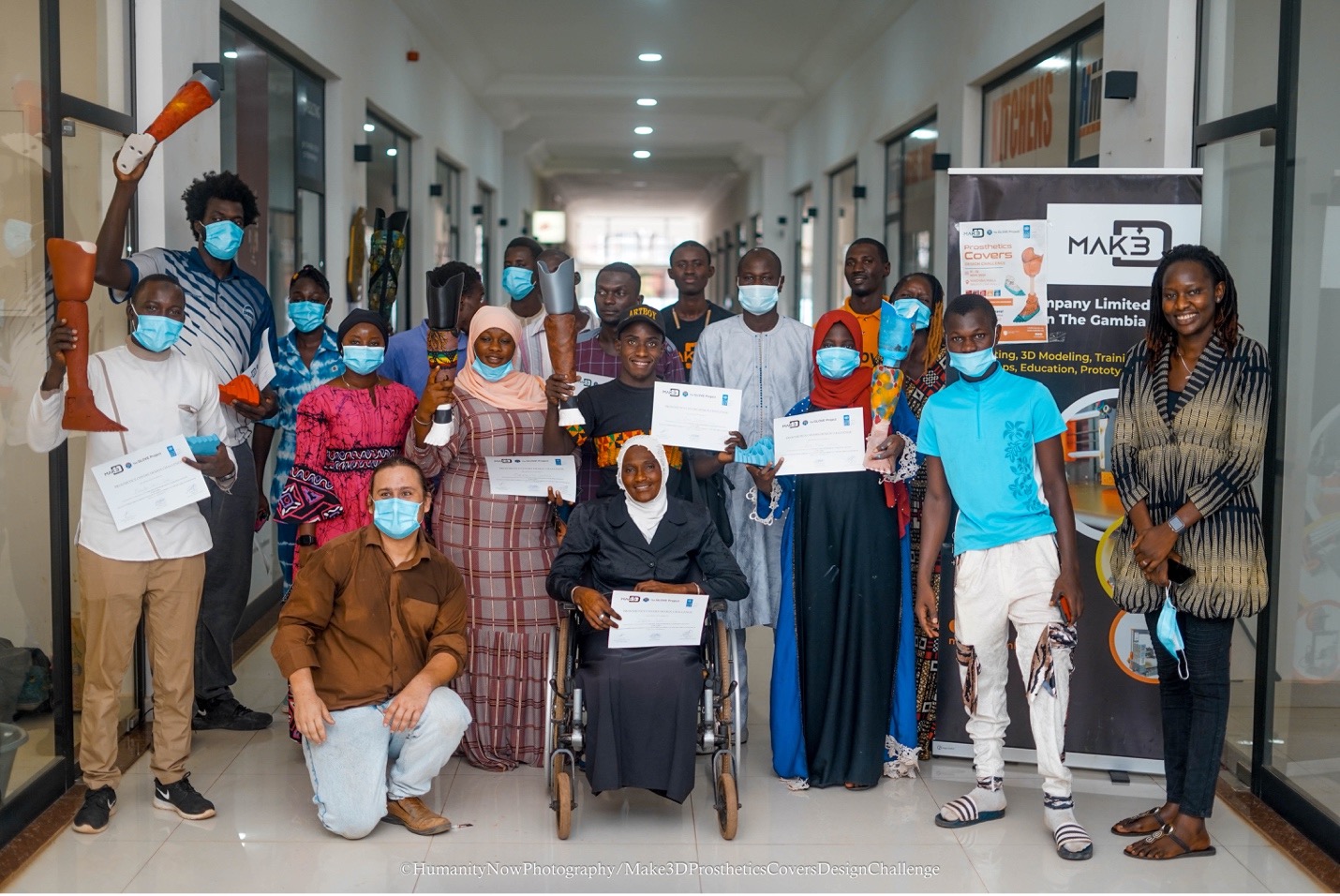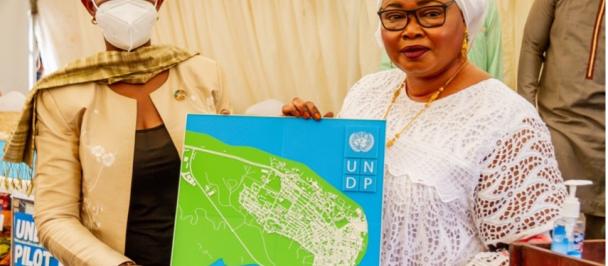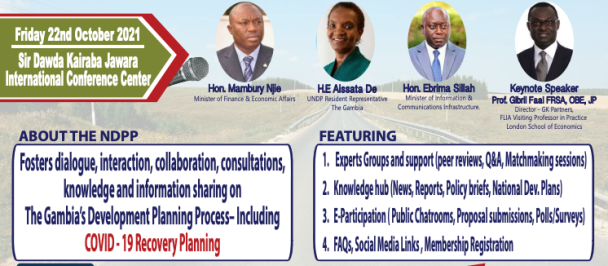3D printed designed prosthetics afoot in The Gambia
August 11, 2022

Final products of the six designs from the 3D printing prosthetics challenge.
Oftentimes we read or hear about “Leaving No One Behind” but how effectively do we ensure that our work truly caters to the most vulnerable in our society? Human rights are fundamental rights and freedoms that are intrinsic to every person by virtue of their status as a human being. In this sense, human rights are ‘inalienable’ because they can neither be given to a person, nor can they be taken away from them. The differently abled or people with disabilities make up a large proportion of the most vulnerable in our society. In 2021, UNDP The Gambia Accelerator Lab sought to challenge ourselves and our Country Office on how we engage with this community. Starting with an innovation challenge for People with Disabilities (PwDs), which was won by the only 3D printing company in the country, Make3D, a 3D printing prosthetics design challenge focusing on amputees become our main flagship portfolio event. The target now is to explore a rehabilitation program to benefit those affected in addition to exploring other prospects for this kind of work in The Gambia, especially if further resources could be mobilized through innovative financing methods such as crowdfunding.
Organizing the Design Challenge
The two-day event featured six competitors all chasing a winning design that sought to provide a lightweight, unique yet visually attractive solution using locally available materials. These could be sourced from pre-selected items provided by the organizers, but the competitors also had a USD50 budget to add to that selection. The winner, a university lecturer who is also an artist, presented a simple, light, and cost-effective design made from recycled barrel plastic. It will now be used in the manufacturing of prosthetics for 5 amputee children nominated by the Department of Social Welfare.
The jury consisting of amputees, health experts from Nottingham Trent University who were there to mentor the groups, NGO representatives, special needs education representatives from the Ministry of Basic and Secondary Education (MoBSE), and a prosthetic technician from the Department of Social Welfare, designed the selection criteria, which included cost-effectiveness, appeal, and weight considerations.
Why use 3D printers?
3D printing is also known as additive manufacturing and is a digital manufacturing process used in almost all industrial sectors. Due to its unique properties of customization on the lowest production unit level, this technology is used to manufacture prosthetics and prosthetic parts, because every prosthetic is practically a unique product. Usually, the workflow consists of an assessment of amputees, 3D scanning, CAD design and production of parts, assembling, and testing. The last four steps are usually iterated until safety, functionality and good fit of the prosthetic is achieved.
Successful incorporation of digital workflow into prosthetic manufacturing requires diverse know-how and expertise including medical, material engineering and, CAD design. 3D printing can provide the following three advantages for prosthetic manufacturing:
- Locally manufactured prosthetic parts are not dependent on import
- Special cases can be fully customized even where the conventional technologies do not provide adequate products
- In some cases, cost reduction can be achieved.
Definitely, 3D printing is not a universal technology to manufacture all prosthetics. However, it can be efficient for specific prosthetic parts.
Event Results
Out of the six competitors, the winning design stood out to the judges because of its simplicity, adjustability, low entry manufacturing costs, and adaptability to various prosthetic legs. Our runner-up presented a sculpted prosthetic cover made from polyurethane foam, which lost points on the basis of being less practical for adjustments, although, it was later identified as the most widely appreciated design by the amputees themselves for providing similar cost and weight properties. Other designs were composed of variously decorated combinations of foam, textile, and colors. One design that stood out was created from recycled plastic bottles.

A participant holds up a design made from recycled plastic water bottles
In recognising these efforts, the runner-up was awarded a 3-month internship opportunity with the Make3D printing company, which will involve working on subsequent prosthetic manufacturing workflows. This will largely depend on agreements with the Department of Social Welfare and other established stakeholders, both locally and internationally, such as experts on the prosthetic rehabilitation process.
How have we responded to challenges?
The most significant challenges are related to linking the relevant stakeholders in The Gambia. A single institution does not have all the expertise therefore collaboration of stakeholders from private (profit, non-profit) and public sectors is crucial to provide safe and efficient solutions for amputees. This area proved to be a bottleneck for wider involvement of 3D printing technology in the prosthetic manufacturing process. And a reason why some essential workflows are only developed but have not yet reached the implementing stage.
Furthermore, the contributing researchers from Nottingham Trent University, are working on prosthetic design improvement to create a safer product manufacturing workflow as we consider how to expand the scale of the project through our main partner, Make3D. Early conclusions from their work already suggests 3D printing to be a safe solution for prosthetics manufacturing. However, manufacturing procedures of full prosthetics - especially properly fitted sockets - are not yet in the final stage to be considered a final product workflow.

Participants of the Design Challenge with the organizers
The road ahead
Innovative and emerging technologies have a role to play in making possible the inclusion of differently abled people in all aspects of life in our society. It is imperative in this 21st century, but we also understand that their successful incorporation into the currently existing structures pose diverse sets of challenges to different societies. To overcome these challenges, collaboration of stakeholders from private and public sectors is necessary and awareness programmes about the capabilities of these technologies need to be more accessible. Programs like design challenges opened the discussion in our local community and also included another important group of stakeholders - artists who contributed to make the final product socially acceptable.
These are the kinds of concerted efforts we need to make in our work as we seek to do development differently. We need to challenge our understanding of social issues which cannot always be communicated after noticing a differently-abled person. Moreover, violation of a human right may deny a person the ability to enjoy or attain the right, but it does not disentitle the person to the respect, protection and fulfilment of the right.
We need to learn to better listen and receive what is being expressed by oftentimes voiceless people who only reach us through one-way communication.
Proper building of the technological capabilities of 3D printing especially to public stakeholders, namely Social Welfare Department, should be done to boost enhancement of conventional methods by digital manufacturing workflows. But why stop there, let’s consider having printing capabilities, or even full-blown maker spaces in international development organizations like the UNDP.

 Locations
Locations



